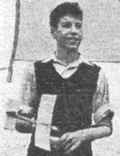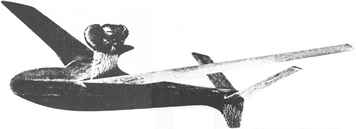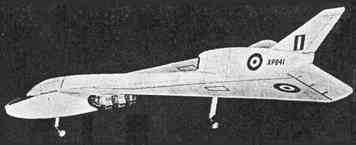Model Aircraft Plans
The Jetex 50 was the most popular of all the Jetex motors. In its various versions, it inspired designers to create a vast range of plans.
We present here a representative selection from this range. These downloadable plans are sourced from designers in the United Kingdom, the United States and France, and cover almost forty years of commercially published Jetex designs.
![]() Midget 50 (Clive Hadland, 1949)
Midget 50 (Clive Hadland, 1949)
![]() Rudolph (Aubrey Kochman, 1950)
Rudolph (Aubrey Kochman, 1950)
![]() Pfupf (P. Maillard, 1951)
Pfupf (P. Maillard, 1951)
![]() Supersonic Wing (Frank Ehling, 1951)
Supersonic Wing (Frank Ehling, 1951)
![]() Hawker Hunter (Bill Dean, 1952)
Hawker Hunter (Bill Dean, 1952)
![]() Arrow 50 (Ian Dowsett, 1953)
Arrow 50 (Ian Dowsett, 1953)
![]() Puk (Jean-Claude Aggéry, 1953)
Puk (Jean-Claude Aggéry, 1953)
![]() Ukkie (C R de Vries, 1953)
Ukkie (C R de Vries, 1953)
![]() Mosca (R. Parlatoré, 1953)
Mosca (R. Parlatoré, 1953)
![]() F-4D Skyray (Bill Dean, 1954)
F-4D Skyray (Bill Dean, 1954)
![]() Folland Midge (Bill Dean, 1955)
Folland Midge (Bill Dean, 1955)
![]() Fizzle-bug (Ian Dowsett, 1955)
Fizzle-bug (Ian Dowsett, 1955)
![]() Super Mystère (Modèle Magazine, 1955)
Super Mystère (Modèle Magazine, 1955)
![]() Fizzle Quick (Ian Dowsett, 1955)
Fizzle Quick (Ian Dowsett, 1955)
![]() Vulture (Bill Dean, 1957)
Vulture (Bill Dean, 1957)
![]() VTO (American Modeler, 1957)
VTO (American Modeler, 1957)
![]() Fizzel Fazzel (Bob Walters, 1959)
Fizzel Fazzel (Bob Walters, 1959)
![]() Fizzle XIII (D.J. Lindley, 1965)
Fizzle XIII (D.J. Lindley, 1965)
![]() Good Times (Bob Stalick, 1976)
Good Times (Bob Stalick, 1976)
![]() Small Wonder (Wayne Brown, 1967)
Small Wonder (Wayne Brown, 1967)
![]() F-19 Stealth (John Emmett, 1987)
F-19 Stealth (John Emmett, 1987)
PAA-Load contest, Junior Jet division:
![]() Jr Jet Record Holder (Paul H. Osborne, 1961)
Jr Jet Record Holder (Paul H. Osborne, 1961)
![]() Dummy Dip 50 (Charles Sotich, 1961)
Dummy Dip 50 (Charles Sotich, 1961)
jjjjj
Midget 50
 Click the button to view Detail page with building and flying hints from Clive Hadland and download plan.
Click the button to view Detail page with building and flying hints from Clive Hadland and download plan.
Detail Page
by Clive Hadland (1949)
Midget 50 earned its young designer, Clive Hadland, second placing in the inaugural ICI Jetex Contest in 1949. He was in the illustrious company of two designers who were to become famous in the aeromodelling scene – Dick Twomey, who gained first place, and Bill Henderson who came third. Unlike his two fellow place-getters, Clive chose to fly with the (then) smallest of the motors, the recently introduced Jetex 50. He wisely kept Midget 50 light and simple in construction with a claimed building time of one evening.
Rudolph
 Click the button to view Detail page with building and flying hints from Aubrey Kockmann and download plan.
Click the button to view Detail page with building and flying hints from Aubrey Kockmann and download plan.
Detail Page
by Aubrey Kochmann (1950)
Rudolph is the first plan published in the United States for a Jetex 50-powered model. Air Trails, which had published the first US Jetex design ever, offered its readers this plan less than a year after Wilmot Mansour had introduced the Jetex 50, and just six months after American Telasco became the official US distributor for Jetex.
Aubrey Kochmann designed this simple all-balsa model to demonstrate the capabilities of the new, smaller motor. His article gives a detailed explanation of the principle of Jetex motive power, for the benefit of a readership still largely unfamiliar with it.
Pfupf
 Click the button to view Detail page with building and flying hints from Graham Knight and download plan.
Click the button to view Detail page with building and flying hints from Graham Knight and download plan.
Detail Page
by P. Maillard (1951)
Taking the lead in promoting the Jetex cause in France was the premier French aeromodelling magazine, Le Modèle Réduit d'Avion. Typical of the Jetex plans it published was the little Pfufp, appearing in a 1951 issue. Our copy of the plan was republished in Vic Smeed's Flying Models – Favourites of the Fifties. More recently, Pfufp has been adapted for Rapier power by Grahan Knight, and we also have Graham's redrawing of the plan available for download.
by Frank Ehling (1951)
“Despite its simplicity and ease of construction (the complete model is made from ¹/16" sheet balsa), the Supersonic Wing is a high-performance craft. And for those modelers who may consider the Jetex 50 a low-powered jet engine capable of little more than a polite hiss, I'd like to advise that a light model properly trimmed for flight will lead you a merry chase over hill and dale. With this model I found it prudent to team up with a good cross-country runner. We spelled each other on the retrieving job!”
by Bill Dean (1952)
“Bill Dean tempted Eagle Annual readers with this “flying model of the famous Hawker Hunter [that] takes just a single evening to build.” As for flying, Bill advised his young readers to “choose a space clear of trees and buildings as the model is capable of long duration flights of up to a quarter of a mile.”
Model Aircraft Plans for the Jetex Atom 35
The Atom 35 was one of the last motors to be introduced by Wilmot Mansour, in 1953. With a annoying propensity to suffer from blow-back and a relatively short duration, fewer designs were produced for this motor.
We currently offer two of those plans, both simple all-balsa models from two of aeromodelling's top designers.
Atom Baby by Bill Dean

Download large dimensioned plan
and building and flying hints from Bill Dean
- Aeromodeller, Nov. 1953 (p.668)
Shortly after the introduction to the market of the Atom 35, the prolific and talented designer Bill Dean was asked by Aeromodeller to turn his hand to a simple design utilising the new motor. Atom Baby is the result.
In his accompanying notes, Bill Dean says:
"This all-sheet design for the new Jetex '35' takes only an hour to make.
"Asked by the Editor to design a beginner's model for the new Jetex " Atom 35 ", we decided to adopt a perfectly conventional layout and concentrate on building simplicity. After selecting the balsa sheet and sitting down at the building board, the average beginner can easily turn out one of these little models in one hour flat."
Handley Page H.P.115 by Doug McHard
 Doug McHard designed this "simple little profile model of Britain's latest research plane" to be put together in less than an hour. He himself was quickly off the mark with his model, the full-scale aircraft having first flown only four months before publication of his plan.
Doug McHard designed this "simple little profile model of Britain's latest research plane" to be put together in less than an hour. He himself was quickly off the mark with his model, the full-scale aircraft having first flown only four months before publication of his plan.
Although the plan and the photo at left show an Atom 35 motor, Doug's H.P.115 was designed to be equally happy with a Jetex 50.
- Model Aircraft, Dec. 1961 (p.384)
Acknowledgements
Plan and information source:
- Atom Baby: article and plan contributed by Bill Henderson
- H.P.115: article and plan contributed by Bruce Ogden and Bill Henderson




